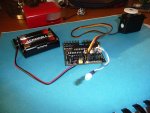hello to all, I hope to be posting in the right section.
I'm a totally newbie, thus this is my first project.
I'm trying to pilot a servo with my PICAXE 28X1 + ProjectBoard, but I'have several issues.
First of all, I soldered a new pin into Output 0's Ground, so now I'm connecting my servo with the yellow wire to the output, the red one on V+ and the black one on the G.
I'm supplying the system with 3 AA 1,5V stylo batteries, non rechargeable.
I replaced the Darlington chip with a 330R resistor and now I'm trying to pilot the servo but I have no results.
I tried to test the tension between output0 ground and V+ and it seems fine, so there's no line problems.
I used this code to run the servo
To check the software i connected a LED on output4 and then I tried to flash it.
used simply the code
The most curious thing is then, once i give to the controller the flashing program as provided, the LED flashes in the strange way I described, even if I connect it to any other output.
I'm guessing what am I doing wrong...

I'm a totally newbie, thus this is my first project.
I'm trying to pilot a servo with my PICAXE 28X1 + ProjectBoard, but I'have several issues.
First of all, I soldered a new pin into Output 0's Ground, so now I'm connecting my servo with the yellow wire to the output, the red one on V+ and the black one on the G.
I'm supplying the system with 3 AA 1,5V stylo batteries, non rechargeable.
I replaced the Darlington chip with a 330R resistor and now I'm trying to pilot the servo but I have no results.
I tried to test the tension between output0 ground and V+ and it seems fine, so there's no line problems.
I used this code to run the servo
then I went to PICAXE->Program... and it was successfully downloaded to the microcontroller, but then nothing happens.init: servo 0,75
main: servopos 0,75
pause 2000
servopos 0,150
pause 2000
servopos 0,255
pause 2000
goto main
To check the software i connected a LED on output4 and then I tried to flash it.
used simply the code
as you provided, and also here there's something strange. When i connected the blue LED to the powered project board, it turned on immediately. And it always stayed turned on, buth when it was givenmain: high 4
pause 1000
low 4
pause 1000
goto main
command, it just become a bit brighter, and whenhigh 4
is given it simply dimes a bit.low 4
The most curious thing is then, once i give to the controller the flashing program as provided, the LED flashes in the strange way I described, even if I connect it to any other output.
I'm guessing what am I doing wrong...


